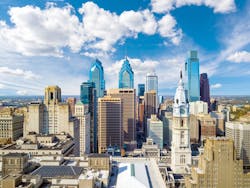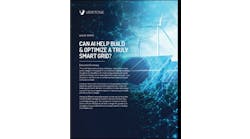Philadelphia will be the site of Microgrid 2020, June 2-3. Here Peter Maloney of Microgrid Knowledge looks at the city’s innovative climate strategies.
By f11photo/Shutterstock.com
Philadelphia Mayor James Kenney earlier this month announced the creation of a private-public partnership that marks the city’s latest effort in battling climate change.
Registration is now open for Microgrid 2020: Distributed Energy and World Electrification
The Climate Collaborative of Greater Philadelphia provides workshops and technical assistance to help businesses and large organizations combat climate change. The first set of workshops focused on procuring renewable energy through off-site power purchase agreements (PPAs).
The initiative grew out of a PPA the city signed about a year ago with Community Solar for the output from a 70 MW solar plant in Adams County, Pennsylvania. The PPA will provide enough electricity to power 22% of Philadelphia’s government buildings, which will move the city closer to its goal of powering the city with 100% renewable energy by 2030.
“Folks were reaching out to us, so we decided to take a different type of leadership role” with groups that operate and construct buildings, said Adam Agalloco, energy manager in Philadelphia’s Office of Sustainability. His office is in the process of figuring out what other topics the collaborative should present in the future to work on.
Vision for Philadelphia
The city’s renewable energy goal sits within the larger framework of goals Kenney set for the city, particularly after President Donald Trump’s June 2017 announcement that he would withdraw the US from the 2015 Paris Agreement on climate change mitigation.
Later the same month, Kenney signed the Sierra Club’s Ready for 100 pledge, committing to a 100% clean energy goal as part of Philadelphia’s long-term commitment to reduce citywide carbon emissions 80% by 2050. To date, 141 cities have signed the Sierra Club’s pledge.
In “Power Our Future: A Clean Energy Vision for Philadelphia,” the city lays out its strategy for achieving its goals. The plan includes installing solar generation on rooftops and other surfaces throughout the city, eliminating energy waste in homes and businesses in the city, working toward clean energy supplies from the wider grid, and taking a low carbon emissions approach to thermal energy in the city.
To reduce thermal energy needs, the city envisions wider electrification of heating and cooling from power derived from clean energy sources, as well as more efficient equipment such as heat pumps. The city is also looking at expanding the use of district heating systems, which provide both electric power and thermal energy from a single plant.
District energy and microgrid projects
Philadelphia already has several district energy systems. Veolia Energy, for instance, operates a natural gas-fired district system that provides steam to the University of Pennsylvania, Drexel University, the Comcast Center and the Philadelphia Museum of Art.
Philadelphia is also exploring the potential of incorporating microgrid projects, particularly those that pair solar power with battery storage, at large new developments. It is already home to one of the nation’s most sophisticated microgrids, located at the Navy Yard.
Both district heating and microgrids are mentioned in Powering Our Future, in the context of the need for resilient, clean energy.
“It is certainly something we are interested in, but we have not yet done a district heating or microgrid roadmap or defined an opportunity or specific potential investments,” Agalloco said.
Reducing the energy use and emissions profiles of building will get Philadelphia a long way toward its goal —nearly 80% of the city’s carbon footprint comes from buildings — but it will not get the city all the way there.
Philadelphia still buys much of its electric power from the regional grid run by the PJM Interconnection and will likely continue to well into the future. But the city has little control over the sources that provide energy for PJM’s grid. While PJM’s grid is getting cleaner, fossil fuels still provide about 63% of PJM’s electrical output.
As Powering Our Future makes clear, clean power from the grid is essential for Philadelphia to meet its goals. “We can’t reach our goals without the grid,” Agalloco said.
Enlisting partners to create demand for clean energy
To that end, the city is enlisting businesses and residents to embrace clean energy as a way of creating more demand for clean energy and to lobby for cleaner energy with campaigns aimed at state legislators. “The state legislature has bigger levers to pull,” Agalloco said.
To some extent, that is already starting to happen. In early October, Gov. Tom Wolf (D) directed the Pennsylvania Department of Environmental Protection to join the Regional Greenhouse Gas Initiative, a market-based collaboration of nine Northeast and Mid-Atlantic states to reduce greenhouse gas emissions and combat climate change.
Making cities members of PJM
Philadelphia is also working with a handful of other cities to figure out a strategy to advocate and become members of PJM as a group, Agalloco said. “We have talked with every major city in PJM.”
PJM members have the right to attend PJM strategy and regulations meetings and vote as stakeholders, which could potentially give those cities, as a group, a greater voice is moving the wholesale regional market closer toward the goals Philadelphia and over 100 other cites cities have set for themselves.
Join Microgrid Knowledge June 2-3 in Philadelpia for Microgrid 2020.







